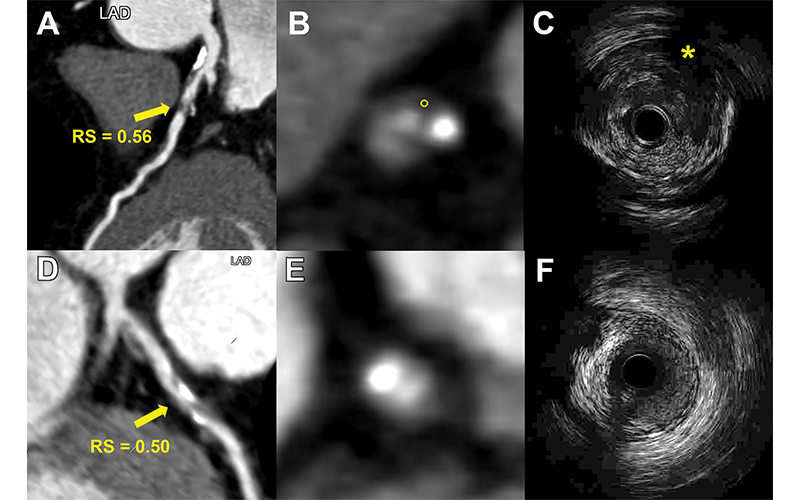Researchers Use Radiomics to Predict Heart Attacks
Approach may help assess potentially vulnerable plaques and stratify high-risk patients

Researchers are using radiomics to predict future cardiac events like heart attacks, according to a study published in Radiology. Radiomics allows researchers to extract quantitative data from CT images that can reveal disease characteristics not visible in the images alone.
Coronary artery disease is linked with plaque accumulation in the artery walls that is vulnerable to rupture. These ruptures are the cause of most heart attacks however, predicting which plaques will rupture is challenging.
Researchers in China developed a radiomics model that uses information from coronary CT angiography images to assess plaque vulnerability. They developed the model in 299 patients. They then studied the approach in 708 patients with suspected coronary artery disease.

Representative images from two patients demonstrate the use of a radiomic signature (RS) to discriminate vulnerable plaques defined with intravascular US. (A–C) Images depict a vulnerable plaque with a high RS. (A) Image from coronary CT angiography (CCTA) shows a partially calcified plaque (arrow) with RS value of 0.56 in the proximal left anterior descending artery (LAD). (B) Corresponding axial CCTA image shows the plaque with low-attenuation area (circle, 25 HU). (C) Corresponding intravascular US scan confirms the plaque as an attenuated plaque (*). (D–F) Images show a nonvulnerable plaque with low RS. (D, E) CCTA images show a partially calcified plaque (arrow in D) with RS value of 0.50 in the proximal left anterior descending artery. (F) Corresponding intravascular US scan confirms the plaque as a partially calcified plaque without echo attenuation and echolucent zone. High versus low RS lesion was defined using an optimal cut-off value of 0.53 (range, 0.46–0.58).
https://pubs.rsna.org/doi/10.1148/radiol.221693 © RSNA 2023
The model enabled the detection of vulnerable plaques associated with an increased risk for major adverse cardiac events like heart attacks. A high radiomic signature was independently associated with these events over a median three-year follow-up.
“The results of this study are encouraging and exciting,” said study co-lead author Long Jiang Zhang, MD, PhD, from the Department of Radiology at Jinling Hospital, Medical School of Nanjing University in China. “Radiomics provided a more accurate approach to detect vulnerable plaques compared to conventional coronary CT angiography anatomical parameters.”
According to Dr. Zhang, the radiomic signature would be easy to add into clinical practice where it could assess potentially vulnerable plaques and help stratify high-risk patients.
“If the radiomics analysis is embedded into the routine CT angiography workstation, it can automatically identify vulnerable plaques for clinician review,” Dr. Zhang said. “Thus, radiomics may significantly improve the accuracy and precision of high-risk plaque detection in routine clinical practice.”
The researchers intend to build a radiomics model from different scanner types and vendors. They also are planning a larger, multicenter study of 10,000 patients.
“With the support of large observational studies and randomized controlled trials, the radiomics approach may help guide clinical decision-making and improve patient care in the future,” Dr. Zhang said.
For More Information
Access the Radiology study, “A Coronary CT Angiography Radiomics Model to Identify Vulnerable Plaque and Predict Cardiovascular Events,” and the related editorial.
Read previous RSNA News articles about radiomics:
- Radiomics May Predict Tumor Mutations in Advanced Stage Colorectal Cancer
- Radiomics Detects New Pathways of Cardiovascular Disease Progression
- Imaging Advancements Pave the Way to Personalized Medicine in Cervical Cancer